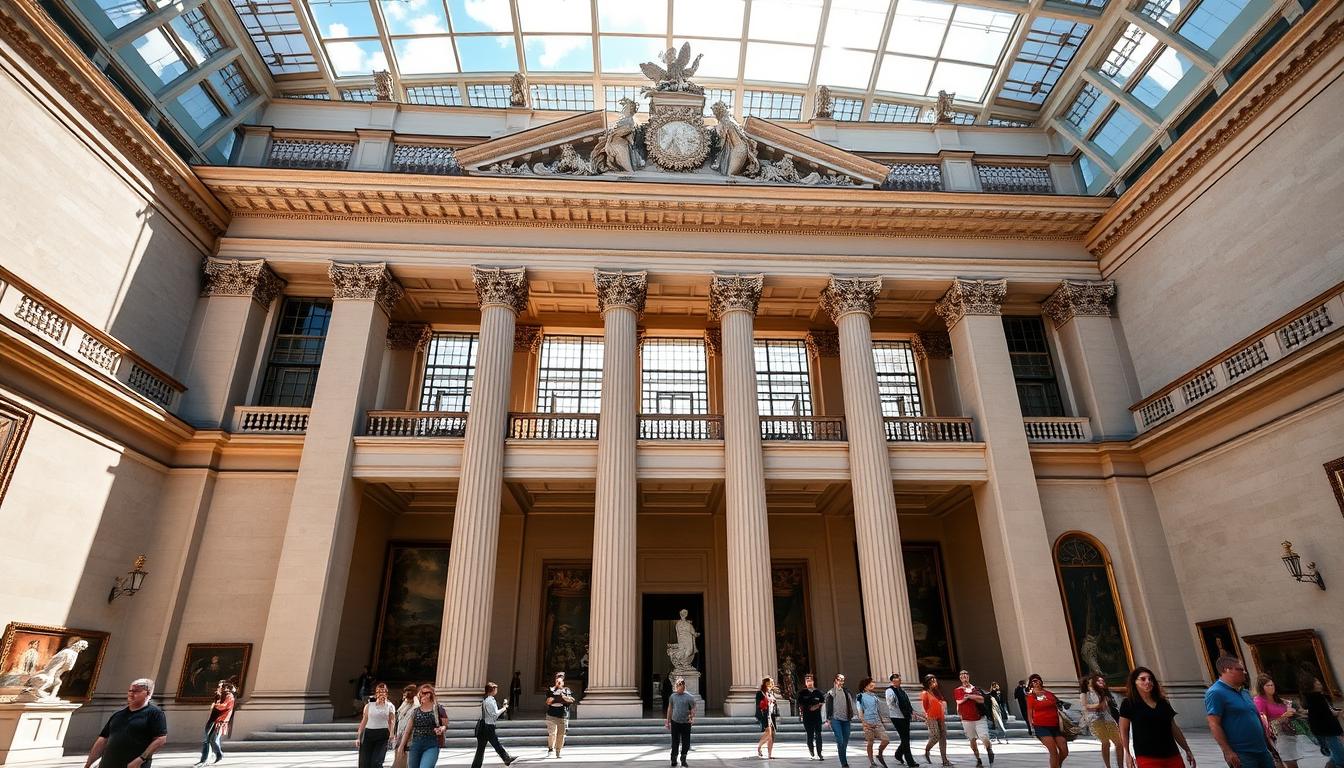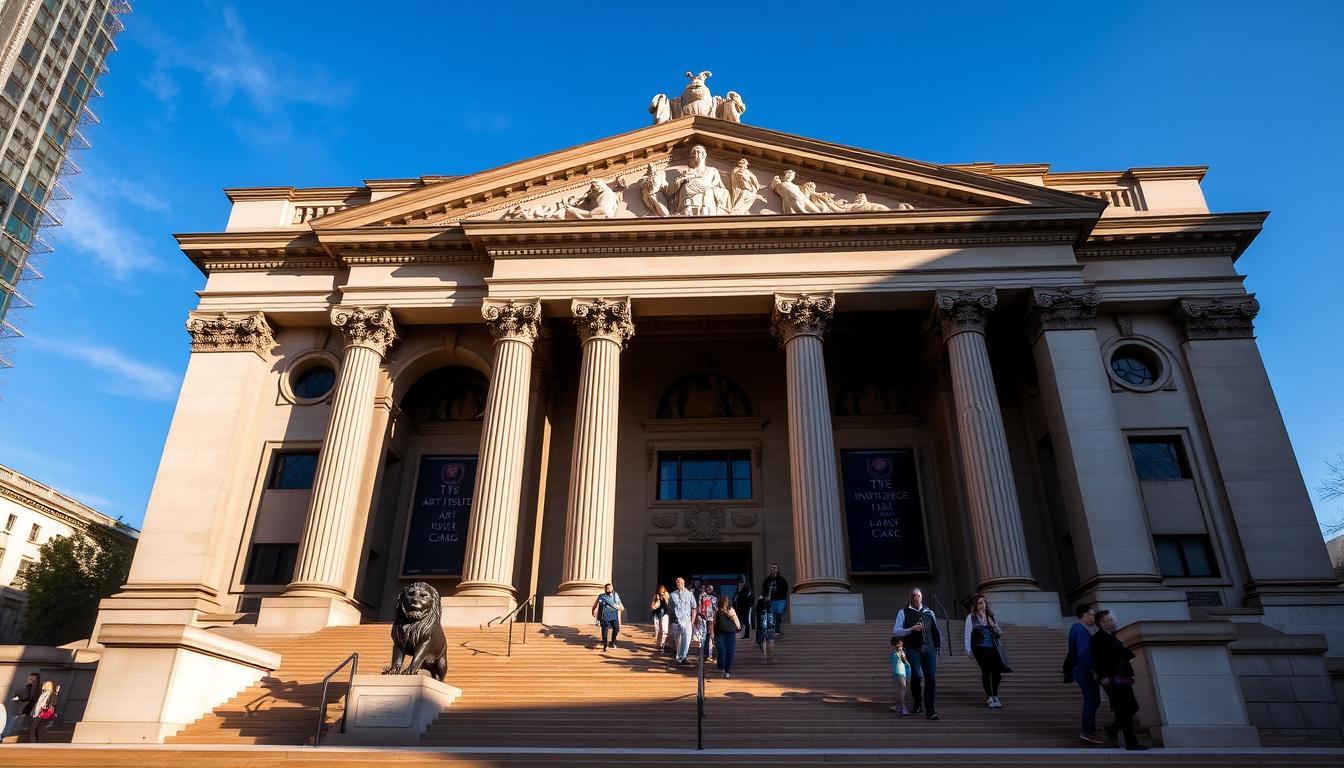What if one visit could reshape how you see art and the world? Step into a campus where grand galleries and intimate rooms sit side by side, inviting you to discover pieces that span 5,000 years and six continents.

The art museum at 1001 Bissonnet St blends bold architecture with a vast collection. Its more than 300,000 square feet of gallery space lets visitors move from ancient works to modern icons with ease.
Established in 1900, this institution ranks among the largest in the united states by gallery space and welcomed nearly a million visitors in 2023. Plan your route to catch headline exhibitions and quiet gems, and use the official site to check hours and special programs.
Whether you have an hour or a full day, expect an inspiring mix of landmark art, thoughtful design, and friendly amenities that make exploring effortless.
Key Takeaways
- The Museum of Fine Arts Houston houses a global collection spanning 5,000 years.
- More than 300,000 square feet of galleries provide comfortable exploration.
- Located at 1001 Bissonnet St with easy Red Line access in the Museum District.
- It ranks among the largest art museums in the united states by gallery space.
- Visitors can enjoy rotating exhibitions, signature works, and on-site amenities.
Why this Houston art museum stands out in the United States today
Scale, depth, and curatorial strength make this houston museum a national standout. It holds roughly 70,000–80,000 objects across more than 300,000 square feet of galleries. In 2023, more than 900,000 visitors explored its halls.
The collections span Italian Renaissance painting, French Impressionism, robust photography, American and European decorative arts, and Pre‑Columbian and African gold. Growing programs in Latin American and Latinx art add fresh perspectives led by the International Center for the Arts of the Americas.
Curators balance blockbuster shows with rotating displays, so regulars and first‑time guests always find something new. Thoughtful campus planning and clear wayfinding make long visits feel easy.
"The institution pairs encyclopedic holdings with active scholarship and community programs."
| Feature | Approx. Count | Benefit |
|---|---|---|
| Objects | 70,000–80,000 | Wide research and display options |
| Gallery space | 300,000+ sq ft | Room for major exhibitions |
| Visitors (2023) | 900,000+ | Strong public engagement |
- Curatorial excellence: loans, conservation, and research.
- Education focus: tours, talks, programs for all ages.
- Approachable experience: clear routes, helpful staff, practical amenities.
Inside the campus: buildings, spaces, and architecture that shape the experience
A campus design that mixes neoclassical form with modern clarity sets the tone for every visit.
Caroline Wiess Law Building
Caroline Wiess Law began with William Ward Watkin’s 1924 neoclassical core. Later additions include the Robert Lee Blaffer wing and two modernist halls by mies van der—Cullinan Hall and the Brown Pavilion—making the wiess law building a defining part of the site.
Audrey Jones Beck & Nancy and Rich Kinder
The audrey jones beck building by Rafael Moneo holds antiquities and European and American works to 1900. The nancy rich kinder building by Steven Holl houses art after 1900 with gardens, a theater, and dining that enhance light and movement.
Gardens, school, and house museums
The cullen sculpture garden (Noguchi) offers open-air respite. The glassell school art provides studios and a rooftop garden. Off-campus, Bayou Bend and Rienzi present period decorative collections.

| Building / Space | Designer | Primary Focus |
|---|---|---|
| Wiess Law Building | Watkin; Mies van der Rohe | Global collections, flexible galleries |
| Beck Building | Rafael Moneo | Antiquities; European & American to 1900 |
| Kinder Building | Steven Holl | Modern & contemporary art after 1900 |
"Architecture guides the visitor as much as the labels do."
Museum of Fine Arts Houston: what to see right now
Follow galleries arranged by period and medium to see how European masters and modern voices converse across time.

Paintings and sculpture highlights
Begin with landmark paintings from the Renaissance through Impressionism — Botticelli, Rembrandt, Monet — then head to early moderns like van Gogh and Cézanne.
Pair these with sculpture indoors and in the gardens for contrast and scale.
Photography, prints, and drawings
The Beck Building rotates photography, prints, and drawings. These shows reveal technique and process and often reframe familiar names in fresh ways.
Latin American and Latinx art
The ICAA’s research enriches displays of latin american art and latin american artists. Expect exhibitions that connect scholarship with striking works.
Decorative arts and design
Explore decorative arts across American and European traditions. For period rooms, consider a visit to Bayou Bend or Rienzi to see furniture, textiles, and interiors in context.
"Mix major masterpieces with smaller galleries; the surprises often change how you see the whole collection."
| Focus | Where to See It | Why It Matters |
|---|---|---|
| Renaissance & Impressionism | Beck & Wiess areas | Signature works that anchor the collection |
| Modern & modern contemporary | Kinder Building | Post‑1900 movements in light‑filled galleries |
| Photography & Works on Paper | Beck Building rotations | Depth in technique and narrative |
| Decorative arts | Bayou Bend, Rienzi | Period context for design and interiors |
- Tip: Alternate media—paintings, sculpture, photography—to keep your visit fresh.
The collections at a glance: breadth, depth, and signature strengths
Visitors encounter centuries of craft and invention arranged so connections between cultures become visible.
European and American painting, 1400–1899
Bold canvases anchor the holdings. The museum fine arts collection includes landmark paintings by Rembrandt, Turner, Monet, and Renoir.
These paintings trace shifts in technique, light, and subject across five centuries. Use the Audrey Jones Beck galleries to follow the story through 1900.
Modern and contemporary art
Post‑1945 work fills light-filled rooms in the Kinder Building. Large-scale painting, sculpture, and time-based media sit comfortably in galleries planned for big ideas.
Global perspectives and decorative strengths
The Caroline Wiess Law holdings bring together Islamic, Asian, Pacific, and African objects. The Glassell Collection of African Gold stands out as a major resource.
Photography and decorative arts appear across rotating displays, while Bayou Bend and Rienzi offer period settings for furniture, textiles, and ceramics.
- Plan: Start at the Beck Building for pre-1900 works, then cross to the Law Building for wider cultural context.
- Don’t miss: the Cullen Sculpture Garden for outdoor sculpture and changing light.
"Masterworks and lesser-known gems in dialogue make each visit surprising."
From 1900 roots to a 21st-century powerhouse: a brief history
What began as a school league in 1900 evolved into a major public art center with lasting civic impact. Community volunteers first gathered art and support, and the site was formally dedicated in 1917.
Early years: the original neoclassical building opened in 1924. Early gifts from George M. Dickson, Annette Finnigan, Ima Hogg, and the Straus family seeded collections that still guide displays today.
Growth and reinvention
Mid‑century expansion modernized galleries. Mies van der additions — Cullinan Hall (1958) and the Brown Pavilion (1974) — opened new possibilities for large-scale works and ambitious exhibitions.
Later moves reshaped the campus. The jones beck Impressionist collection arrived on loan in 1974 and became a gift in 1998, leading to the Audrey Jones Beck building in 2000. The ICAA (2001) boosted latin american research, and the Kinder Building (2020) created sweeping spaces for post‑1900 art.
"Across leadership tenures, a focus on building collections, caring for works, and engaging audiences has shaped a culture of access and excellence."
| Era | Key Dates | Impact |
|---|---|---|
| Founding & early gifts | 1900–1944 | Core holdings and public mission established |
| Modern expansion | 1958–1974 | New galleries by Mies van der Rohe; modern display capacity |
| Contemporary growth | 1998–2020 | Beck gift, ICAA, Kinder Building—broader scholarship & galleries |
- Then: decorative arts and historic collections were secured through major gifts.
- Now: the law building and newer pavilions host rotating shows and long-term research initiatives.
Plan your visit: location, access, and amenities
The site at 1001 Bissonnet St sits in the Museum District and is easy to reach. Take the METRORail Red Line to the Museum District stop, hop a rideshare, or use the on-site parking garage for a smooth start.
Where it is and how to get there
Getting there and first steps
Begin at the kinder building for a bright welcome and clear wayfinding. From there, the campus map or the museum app helps you move to the beck building, the wiess law building, and other galleries without missing key works.
Dining and downtime
Eat, rest, and recharge
Plan a meal at Le Jardinier for contemporary French fare or grab a quick bite at Café Leonelli in the rich kinder building. Both sit conveniently near galleries so you can pause without losing momentum.
Step outside to the cullen sculpture garden for a restorative break. The garden offers seating and shade and places notable works in shifting light.
Smart tips for visitors
Tickets, timing, and resources
- Check mfah.org for current exhibitions, timed entry, discounts, and free admission windows.
- Allow two to three hours for highlights; plan a full day to include Bayou Bend or Rienzi house collections.
- Visit the Glassell School of Art rooftop for skyline views and public programs that extend the campus experience.
- Families: use elevators and rest areas and aim for weekday mornings to avoid crowds.
| Need | Tip | Where |
|---|---|---|
| Transit | METRORail Red Line | 1001 Bissonnet St |
| Dining | Le Jardinier, Café Leonelli | rich kinder building |
| Downtime | Cullen sculpture garden | On campus |
Conclusion
You’ll find bold showcases and intimate discoveries across the museum’s interconnected buildings and serene gardens. The institution combines scale, scholarship, and warmth — making every visit feel both grand and deeply personal.
From the Kinder Building’s contemporary galleries to the Audrey Jones Beck and Law Building anchors, the campus guides you through painting, sculpture, and photography that span centuries. The Cullen Sculpture Garden, Glassell School, Bayou Bend, and Rienzi extend the collection beyond traditional gallery walls, inviting art into the open air and everyday life.
Whether you focus on American art, Latin American creativity, or global masterpieces, plan ahead, pace yourself, and blend celebrated highlights with quieter moments of reflection. Begin planning your next visit — this museum of fine arts continues to offer new reasons to return.
At Rossetti Art, we share this devotion to timeless beauty and emotional design. Our curated collections of canvas prints, original paintings, and modern sculptures by Chiara Rossetti bring the spirit of the gallery into your home. Each piece is more than décor — it’s a reflection of who you are, what you feel, and how you see the world. Explore our collection and let art transform your space into a living masterpiece.
FAQ
What are the main buildings and sites to visit on the campus?
The campus includes the Caroline Wiess Law Building with Mies van der Rohe galleries, the Audrey Jones Beck Building designed by Rafael Moneo, the Nancy and Rich Kinder Building for modern and contemporary art, the Lillie and Hugh Roy Cullen Sculpture Garden by Isamu Noguchi, the Glassell School of Art with studios and a rooftop garden, plus the house museums Bayou Bend and Rienzi.
Which building houses ancient, European, and early American collections?
The Audrey Jones Beck Building showcases antiquities, European painting, and American works through about 1900, all arranged in galleries designed for quiet, close-looking visits.
Where can I see modern and contemporary galleries after 1900?
The Nancy and Rich Kinder Building focuses on art after 1900, with rotating shows of painting, sculpture, photography, and new media across expansive, naturally lit galleries.
What should I know about the sculpture garden?
The Lillie and Hugh Roy Cullen Sculpture Garden offers outdoor works by major 20th-century sculptors and a landscaped urban oasis that complements indoor collections—ideal for breaks between galleries and for photography.
Does the campus offer art education and studio classes?
Yes. The Glassell School of Art runs studio classes, community programs, and artist residencies. Check the school’s schedule for workshops, youth classes, and continuing-education options.
What highlights should I see right now in the collection?
Highlights include European and American paintings from the Renaissance to the 19th century, modern and contemporary icons from post-1945, rich photography and works on paper, and growing Latin American and Latinx collections. Special exhibitions rotate, so check current listings online before you go.
Are there notable photography or works on paper galleries?
Yes. The institution maintains deep holdings in photography, prints, and drawings that span the 20th century to today, often featured in focused exhibitions and study galleries.
How does the campus represent Latin American and Latinx art?
The museum has expanded research, exhibitions, and acquisitions for Latin American and Latinx art, often in collaboration with academic partners and the ICAA, spotlighting both historical and contemporary voices.
What decorative arts and design collections can visitors expect?
Visitors will find American and European decorative arts across house museums like Bayou Bend and Rienzi, plus design objects in main galleries that highlight craftsmanship and historical context.
Which European and American masters are represented in the collection?
The collection includes works by Rembrandt, Monet, Renoir, and other key European masters, alongside major American painters from the 18th through 19th centuries. Rotating displays and loans mean specific works vary over time.
How broad is the global art representation?
The holdings span Africa, Asia, the Islamic world, Pre-Columbian art, and African gold, offering global perspectives that complement European and American strengths.
What are the origins and key moments in the institution’s history?
Roots trace to the Houston Art League and the 1924 opening. Major moments include transformative gifts like the Beck collection, Mies van der Rohe expansions, and the recent Kinder Building addition that reshaped the campus for the 21st century.
Where is the campus located and how do I get there?
The main address is 1001 Bissonnet Street in the Museum District. It’s accessible via the Red Line light rail, local buses, and rideshare services. Parking and drop-off info are available online.
What dining options and visitor amenities are available?
Onsite dining includes Le Jardinier and Café Leonelli, plus casual options near galleries. Amenities include coat check, lockers, accessible restrooms, and seating throughout galleries for rest and reflection.
Any tips for a smooth visit—tickets, timing, and online resources?
Buy timed-entry tickets in advance for peak times, arrive early for quieter galleries, and consult mfah.org for current exhibitions, programs, and accessibility services. Memberships unlock benefits like priority entry and discounts.





Leave a comment
This site is protected by hCaptcha and the hCaptcha Privacy Policy and Terms of Service apply.